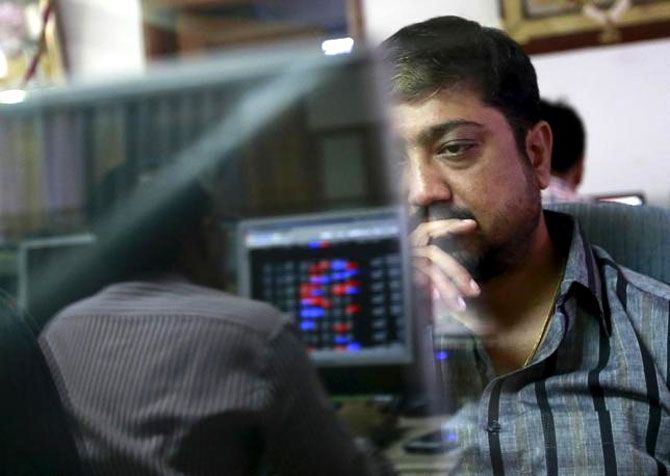Longest period of price-earnings expansion in the index since 1996

Market valuation is up for the fourth consecutive year in 2015, a first in the last twenty years. The benchmark Sensex is now trading at a little under 20 times the underlying earnings of its 30 constituent companies, up from the price-earnings multiple of around 19 times at the end of last calendar year. The benchmark valuation (P/E) is up from the 16.4 times earnings - the low of December 2011 - to 19.6 times now.
This is longest period of valuation expansion in the index since 1996. The previous record was during the boom years of 2004-07 when the Sensex earnings multiple expanded from 17x at the end of 2004 to a peak at 27.7x by the end of 2007. This boom was followed by the crash the following year when valuation dipped to a 13-year low of 12.4x by the end of 2008.
The analysis is based on the year-end Sensex value and the index trailing price-to-earnings multiple for the last 20 years. The index underlying earnings (per share) have been calculated by inverting the P/E ratios for respective years.
The current rally has lasted longer despite poor earnings growth compared to the previous boom. During 2004-07, Sensex companies’ underlying earnings had grown at a compounded annual growth rate (CAGR) of 23 per cent.
In contrast, the underlying earnings are down 10.1 per cent in 2015 and a third (11 out of 30 companies) of the index companies reported profit decline during the 12-months ending September this year. In all, the underlying earnings of the index companies have grown at CAGR of 8.7 per cent since the close of 2011.
Meanwhile, the index has appreciated at the rate of 13.7 per cent during the period. Investors have earned double-digit returns in the last four years despite 6 per cent fall in the benchmark index in the current calendar.
The current year is also the first occasion in a decade when the BSE Midcap and the BSE Smallcap indices have outperformed the benchmark Sensex for the second year in a row. In the past, they used to beat each other every alternate year - an outperformance in Sensex followed by a better show by mid and small cap shares the following year and vice versa.
BSE Midcap and Smallcap indices are up 5.9 per cent and 5.3 per cent, respectively, in 2015 against 6 per cent decline in the benchmark. Last year, the former were up 54.7 per cent and 69.2 per cent, respectively, beating the Sensex which appreciated 30 per cent.
The growing mismatch between corporate earnings and stock market valuations raises the prospects of a market correction in the New Year and quite a few analysts are suggesting that investors should remain cautious.
“The rally is driven by the hope of an imminent revival in the economy and corporate earnings. Corporate earnings have disappointed in the previous two quarters, creating a wedge between valuations and underlying fundamentals. I will advise investors to be cautious in the next year so as to avoid surprises,” says G Chokkalingam, founder & CEO, Equinomics Research & Advisory.
While Chokkalingam remains hopeful of an earnings revival in 2016, he doesn’t rule out a nasty surprise given deflationary pressure in the world’s major economies. “Six countries have pushed interest rates into negative zone in a bid to fight deflationary pressure in their economies. This is a big overhang on India Inc, and we have to be watchful about this,” he adds.
Others blame it on the elevated base last year besides unexpected earnings contraction in few large companies. “The current high valuation is an optical illusion as earnings peaked last year due to the festival season falling in the September quarter. This year, the festival season was pushed into the December quarter, spoiling year-on-year comparison,” says Anoop Bhaskar, head - equities, UTI Mutual Fund. The current Sensex earnings capture corporate results for the 12-months ending September this year.
Bhaskar expects the valuation ratio to “normalise” in 2016. “Valuations have peaked and will moderate as the base effect of poor earnings and lower commodity prices kicks in during the New Year,” he adds.
Thus, investors could expect faster earnings growth in 2016 because of the above reasons, but experts say stock prices are unlikely to rise as rapidly, which in turn, will result in a reduction of the P/E multiple. This is unlike what we have seen in the past few years, when nearly half of the stock returns came from valuation expansion or stock re-rating rather than from earnings growth.
| Sensex valuation and the underlying earnings growth | ||||
| Year | Earnings Growth (%) | PE Ratio (RHS) | ||
| 1996 | 30.0 | 12.2 | ||
| 1997 | 7.5 | 13.5 | ||
| 1998 | -7.0 | 12.1 | ||
| 1999 | -8.7 | 21.7 | ||
| 2000 | -15.2 | 20.3 | ||
| 2001 | 7.0 | 15.6 | ||
| 2002 | 10.1 | 14.6 | ||
| 2003 | 34.2 | 18.9 | ||
| 2004 | 24.9 | 17.1 | ||
| 2005 | 30.6 | 18.6 | ||
| 2006 | 20.0 | 22.8 | ||
| 2007 | 21.0 | 27.7 | ||
| 2008 | 5.8 | 12.4 | ||
| 2009 | 0.7 | 22.4 | ||
| 2010 | 11.4 | 23.6 | ||
| 2011 | 8.2 | 16.4 | ||
| 2012 | 17.7 | 17.5 | ||
| 2013 | 6.5 | 17.9 | ||
| 2014 | 23.9 | 18.8 | ||
| 2015 | -10.1 | 19.6 | ||
| Note: Earnings growth based on year-end value and price to earnings multiple of Sensex | ||||
| 2015 data for trade ended on December 23 | ||||
| Source: Bloomberg | ||||
| Compiled by BS Research Bureau | ||||










 © 2025 Rediff.com -
© 2025 Rediff.com -